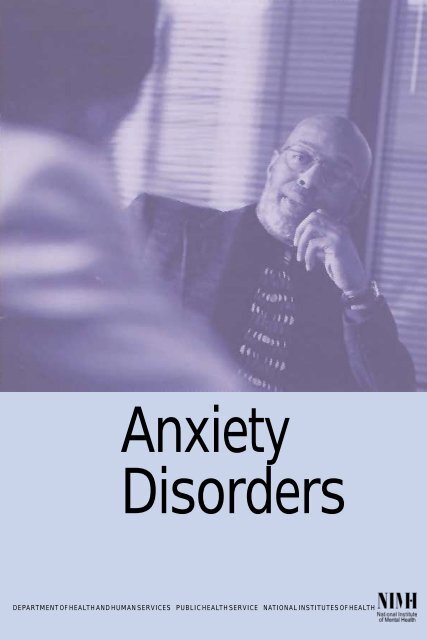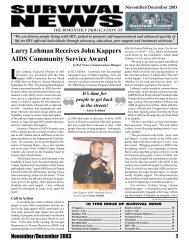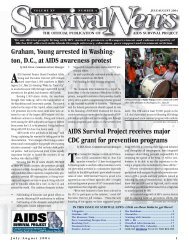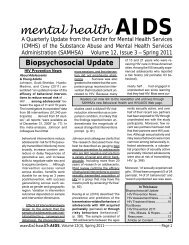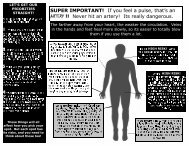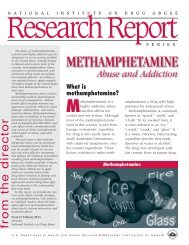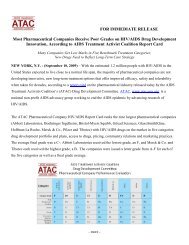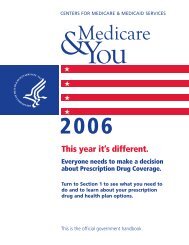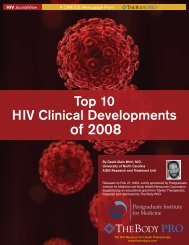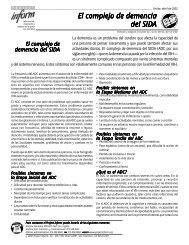Anxiety Disorders - CD8 T cells
Anxiety Disorders - CD8 T cells
Anxiety Disorders - CD8 T cells
You also want an ePaper? Increase the reach of your titles
YUMPU automatically turns print PDFs into web optimized ePapers that Google loves.
<strong>Anxiety</strong><br />
<strong>Disorders</strong><br />
DEPARTMENT O F HEALTH AND HUMAN SERVICES PUBLIC HEALTH SERVICE NATIONAL INSTITUTES O F HEALTH
For more information on research into the brain, behavior, and<br />
mental disorders contact:<br />
National Institute of Mental Health<br />
Information Resources and Inquiries Branch<br />
6001 Executive Boulevard, Room 8184, MSC 9663<br />
Bethesda, Maryland 20892-9663<br />
Telephone: 1-301-443-4513<br />
TTY: 1-301-443-8431<br />
FAX: 1-301-443-4279<br />
Mental Health FAX 4U: 1-301-443-5158<br />
E-mail: nimhinfo@nih.gov<br />
Website: http://www.nimh.nih.gov
nxiety disorders are<br />
serious medical<br />
illnesses that affect<br />
approximately 19<br />
million American<br />
adults. 1 These<br />
Adisorders fill people’s lives with overwhelming anxiety<br />
and fear. Unlike the relatively mild, brief anxiety caused<br />
by a stressful event such as a business presentation or<br />
a first date, anxiety disorders are chronic, relentless,<br />
and can grow progressively worse if not treated.<br />
Effective treatments for anxiety disorders are<br />
available, and research is yielding new, improved<br />
therapies that can help most people with anxiety<br />
disorders lead productive, fulfilling lives. If you think<br />
you have an anxiety disorder, you should seek<br />
information and treatment.<br />
This brochure will<br />
■ help you identify the symptoms of anxiety<br />
disorders,<br />
■ explain the role of research in understanding
the causes of these conditions,<br />
■ describe effective treatments,<br />
■ help you learn how to obtain treatment and work with a<br />
doctor or therapist, and<br />
■ suggest ways to make treatment more effective.<br />
The anxiety disorders discussed in this brochure are<br />
■ panic disorder,<br />
■ obsessive-compulsive disorder,<br />
■ post-traumatic stress disorder,<br />
■ social phobia (or social anxiety disorder),<br />
■ specific phobias, and<br />
■ generalized anxiety disorder.<br />
Each anxiety disorder has its own distinct features, but they<br />
are all bound together by the common theme of excessive,<br />
irrational fear and dread.<br />
The National Institute of Mental Health (NIMH) supports<br />
scientific investigation into the causes, diagnosis, treatment, and<br />
prevention of anxiety disorders and other mental illnesses. The<br />
NIMH mission is to reduce the burden of mental illness through<br />
research on mind, brain, and behavior. NIMH is a component of the<br />
National Institutes of Health, which is part of the U.S. Department<br />
of Health and Human Services.<br />
Panic Disorder<br />
“It started 10 years ago, when I had just graduated from college and<br />
started a new job. I was sitting in a business seminar in a hotel and<br />
this thing came out of the blue. I felt like I was dying.<br />
2
“For me, a panic attack is almost a violent experience. I feel<br />
disconnected from reality. I feel like I’m losing control in a very<br />
extreme way. My heart pounds really hard, I feel like I can’t get my<br />
breath, and there’s an overwhelming feeling that things are crashing in<br />
on me.<br />
“In between attacks there is this dread and anxiety that it’s going<br />
to happen again. I’m afraid to go back to places where I’ve had an<br />
attack. Unless I get help, there soon won’t be anyplace where I can go<br />
and feel safe from panic.”<br />
People with panic disorder have feelings of terror that strike<br />
suddenly and repeatedly with no warning. They can’t predict when<br />
an attack will occur, and many develop intense anxiety between<br />
episodes, worrying when and where the next one will strike.<br />
If you are having a panic attack, most likely your heart will<br />
pound and you may feel sweaty, weak, faint, or dizzy. Your hands<br />
may tingle or feel numb, and you might feel flushed or chilled. You<br />
may have nausea, chest pain or smothering sensations, a sense of<br />
unreality, or fear of impending doom or loss of control. You may<br />
genuinely believe you’re having a heart attack or losing your mind,<br />
or on the verge of death.<br />
Panic attacks can occur at any time, even during sleep. An<br />
attack generally peaks within 10 minutes, but some symptoms<br />
may last much longer.<br />
Panic disorder affects about 2.4 million adult Americans1 and<br />
is twice as common in women as in men. 2 It most often begins<br />
during late adolescence or early adulthood. 2 Risk of developing<br />
panic disorder appears to be inherited. 3 Not everyone who<br />
experiences panic attacks will develop panic disorder—for example,<br />
many people have one attack but never have another. For those<br />
3
who do have panic disorder, though, it’s important to seek<br />
treatment. Untreated, the disorder can become very disabling.<br />
Many people with panic disorder visit the hospital emergency<br />
room repeatedly or see a number of doctors before they obtain a<br />
correct diagnosis. Some people with panic disorder may go for<br />
years without learning that they have a real, treatable illness.<br />
Panic disorder is often accompanied by other serious<br />
conditions such as depression, drug abuse, or alcoholism4,5 and<br />
may lead to a pattern of avoidance of places or situations where<br />
panic attacks have occurred. For example, if a panic attack strikes<br />
while you’re riding in an elevator, you may develop a fear of<br />
elevators. If you start avoiding them, that could affect your choice<br />
of a job or apartment and greatly restrict other parts of your life.<br />
Some people’s lives become so restricted that they avoid<br />
normal, everyday activities such as grocery shopping or driving. In<br />
some cases they become housebound. Or, they may be able to<br />
confront a feared situation only if accompanied by a spouse or<br />
other trusted person.<br />
Basically, these people avoid any situation in which they<br />
would feel helpless if a panic attack were to occur. When people’s<br />
lives become so restricted, as happens in about one-third of people<br />
with panic disorder, 2 the condition is called agoraphobia. Early<br />
treatment of panic disorder can often prevent agoraphobia.<br />
Panic disorder is one of the most treatable of the anxiety<br />
disorders, responding in most cases to medications or carefully<br />
targeted psychotherapy.<br />
You may genuinely believe you’re having a heart attack,<br />
losing your mind, or are on the verge of death. Attacks<br />
can occur at any time, even during sleep.<br />
4
Depression<br />
Depression often accompanies anxiety disorders 4 and, when it does, it needs to<br />
be treated as well. Symptoms of depression include feelings of sadness,<br />
hopelessness, changes in appetite or sleep, low energy, and difficulty<br />
concentrating. Most people with depression can be effectively treated with<br />
antidepressant medications, certain types of psychotherapy, or a combination<br />
of both.<br />
Obsessive-Compulsive Disorder<br />
“I couldn’t do anything without rituals. They invaded every aspect of<br />
my life. Counting really bogged me down. I would wash my hair three<br />
times as opposed to once because three was a good luck number and<br />
one wasn’t. It took me longer to read because I’d count the lines in a<br />
paragraph. When I set my alarm at night, I had to set it to a number<br />
that wouldn’t add up to a ‘bad’ number.<br />
“Getting dressed in the morning was tough because I had a routine,<br />
and if I didn’t follow the routine, I’d get anxious and would have to get<br />
dressed again. I always worried that if I didn’t do something, my<br />
parents were going to die. I’d have these terrible thoughts of harming<br />
my parents. That was completely irrational, but the thoughts triggered<br />
more anxiety and more senseless behavior. Because of the time I spent<br />
on rituals, I was unable to do a lot of things that were important to me.<br />
“I knew the rituals didn’t make sense, and I was deeply ashamed<br />
of them, but I couldn’t seem to overcome them until I had therapy.”<br />
5
Obsessive-compulsive disorder, or OCD, involves anxious<br />
thoughts or rituals you feel you can’t control. If you have OCD, you<br />
may be plagued by persistent, unwelcome thoughts or images, or<br />
by the urgent need to engage in certain rituals.<br />
You may be obsessed with germs or dirt, so you wash your<br />
hands over and over. You may be filled with doubt and feel the<br />
need to check things repeatedly. You may have frequent thoughts<br />
of violence, and fear that you will harm people close to you. You<br />
may spend long periods touching things or counting; you may be<br />
preoccupied by order or symmetry; you may have persistent<br />
thoughts of performing sexual acts that are repugnant to you; or<br />
you may be troubled by thoughts that are against your religious<br />
beliefs.<br />
The disturbing thoughts or images are called obsessions, and<br />
the rituals that are performed to try to prevent or get rid of them<br />
are called compulsions. There is no pleasure in carrying out the<br />
rituals you are drawn to, only temporary relief from the anxiety<br />
that grows when you don’t perform them.<br />
A lot of healthy people can identify with some of the symptoms<br />
of OCD, such as checking the stove several times before<br />
leaving the house. But for people with OCD, such activities<br />
consume at least an hour a day, are very distressing, and interfere<br />
with daily life.<br />
Most adults with this condition recognize that what they’re<br />
doing is senseless, but they can’t stop it. Some people, though,<br />
particularly children with OCD, may not realize that their behavior<br />
is out of the ordinary.<br />
OCD afflicts about 3.3 million adult Americans. 1 It strikes<br />
men and women in approximately equal numbers and usually first<br />
appears in childhood, adolescence, or early adulthood. 2 One-third<br />
of adults with OCD report having experienced their first symptoms<br />
as children. The course of the disease is variable—symptoms may<br />
come and go, they may ease over time, or they can grow<br />
6
progressively worse. Research evidence suggests that OCD might<br />
run in families. 3<br />
Depression or other anxiety disorders may accompany<br />
OCD2,4 , and some people with OCD also have eating disorders. 6 In<br />
addition, people with OCD may avoid situations in which they might<br />
have to confront their obsessions, or they may try unsuccessfully to<br />
use alcohol or drugs to calm themselves. 4,5 If OCD grows severe<br />
enough, it can keep someone from holding down a job or from<br />
carrying out normal responsibilities at home.<br />
OCD generally responds well to treatment with medications or<br />
carefully targeted psychotherapy.<br />
The disturbing thoughts or images are called obsessions,<br />
and the rituals performed to try to prevent or get rid of<br />
them are called compulsions. There is no pleasure in<br />
carrying out the rituals you are drawn to, only temporary<br />
relief from the anxiety that grows when you don’t perform<br />
them.<br />
Post-Traumatic Stress Disorder<br />
“I was raped when I was 25 years old. For a long time, I spoke about<br />
the rape as though it was something that happened to someone else. I<br />
was very aware that it had happened to me, but there was just no<br />
feeling.<br />
“Then I started having flashbacks. They kind of came over me like<br />
a splash of water. I would be terrified. Suddenly I was reliving the<br />
rape. Every instant was startling. I wasn’t aware of anything around<br />
7
me, I was in a bubble, just kind of floating. And it was scary. Having a<br />
flashback can wring you out.<br />
“The rape happened the week before Thanksgiving, and I can’t<br />
believe the anxiety and fear I feel every year around the anniversary<br />
date. It’s as though I’ve seen a werewolf. I can’t relax, can’t sleep,<br />
don’t want to be with anyone. I wonder whether I’ll ever be free of this<br />
terrible problem.”<br />
Post-traumatic stress disorder (PTSD) is a debilitating<br />
condition that can develop following a terrifying event. Often,<br />
people with PTSD have persistent frightening thoughts and<br />
memories of their ordeal and feel emotionally numb, especially<br />
with people they were once close to. PTSD was first brought to<br />
public attention by war veterans, but it can result from any<br />
number of traumatic incidents. These include violent attacks such<br />
as mugging, rape or torture; being kidnapped or held captive; child<br />
abuse; serious accidents such as car or train wrecks; and natural<br />
disasters such as floods or earthquakes. The event that triggers<br />
PTSD may be something that threatened the person’s life or the life<br />
of someone close to him or her. Or it could be something<br />
witnessed, such as massive death and destruction after a building<br />
is bombed or a plane crashes. In the aftermath of the events of<br />
September 11, 2001, both adults and children have struggled with<br />
the emotional impact of large-scale damage and loss of life.<br />
Whatever the source of the problem, some people with PTSD<br />
repeatedly relive the trauma in the form of nightmares and<br />
disturbing recollections during the day. They may also experience<br />
other sleep problems, feel detached or numb, or be easily startled.<br />
They may lose interest in things they used to enjoy and have trouble<br />
feeling affectionate. They may feel irritable, more aggressive than<br />
before, or even violent. Things that remind them of the trauma may<br />
be very distressing, which could lead them to avoid certain places or<br />
8
situations that bring back those memories. Anniversaries of the<br />
traumatic event are often very difficult.<br />
PTSD affects about 5.2 million adult Americans. 1 Women are<br />
more likely than men to develop PTSD. 7 It can occur at any age,<br />
including childhood, 8 and there is some evidence that susceptibility<br />
to PTSD may run in families. 9 The disorder is often accompanied by<br />
depression, substance abuse, or one or more other anxiety<br />
disorders. 4 In severe cases, the person may have trouble working or<br />
socializing. In general, the symptoms seem to be worse if the event<br />
that triggered them was deliberately initiated by a person—such as<br />
a rape or kidnapping.<br />
Ordinary events can serve as reminders of the trauma and<br />
trigger flashbacks or intrusive images. A person having a<br />
flashback, that can come in the form of images, sounds, smells,<br />
or feelings, may lose touch with reality and may feel as though the<br />
traumatic event is happening all over again.<br />
Not every traumatized person gets full-blown PTSD, or<br />
experiences PTSD at all. PTSD is diagnosed only if the symptoms<br />
last more than a month. In those who do develop PTSD, symptoms<br />
usually begin within 3 months of the trauma, and the course of the<br />
illness varies. Some people recover within 6 months, others have<br />
symptoms that last much longer. In some cases, the condition may<br />
be chronic. Occasionally, the illness doesn’t show up until years<br />
after the traumatic event.<br />
People with PTSD can be helped by medications and carefully<br />
targeted psychotherapy.<br />
Ordinary events can serve as reminders of the trauma and<br />
trigger flashbacks or intrusive images. Anniversaries of<br />
the traumatic event are often very difficult.<br />
9
Social Phobia<br />
(Social <strong>Anxiety</strong> Disorder)<br />
“In any social situation, I felt fear. I would be anxious before I even left<br />
the house, and it would escalate as I got closer to a college class, a<br />
party, or whatever. I would feel sick at my stomach—it almost felt like I<br />
had the flu. My heart would pound, my palms would get sweaty, and I<br />
would get this feeling of being removed from myself and from<br />
everybody else.<br />
“When I would walk into a room full of people, I’d turn red and it<br />
would feel like everybody’s eyes were on me. I was embarrassed to<br />
stand off in a corner by myself, but I couldn’t think of anything to say to<br />
anybody. It was humiliating. I felt so clumsy, I couldn’t wait to get out.<br />
“I couldn’t go on dates, and for a while I couldn’t even go to class.<br />
My sophomore year of college I had to come home for a semester. I felt<br />
like such a failure.”<br />
Social phobia, also called social anxiety disorder, involves<br />
overwhelming anxiety and excessive self-consciousness in<br />
everyday social situations. People with social phobia have a<br />
persistent, intense, and chronic fear of being watched and judged<br />
by others and being embarrassed or humiliated by their own<br />
actions. Their fear may be so severe that it interferes with work or<br />
school, and other ordinary activities. While many people with<br />
social phobia recognize that their fear of being around people may<br />
be excessive or unreasonable, they are unable to overcome it. They<br />
often worry for days or weeks in advance of a dreaded situation.<br />
Social phobia can be limited to only one type of situation—<br />
such as a fear of speaking in formal or informal situations, or<br />
10
eating, drinking, or writing in front of others—or, in its most<br />
severe form, may be so broad that a person experiences symptoms<br />
almost anytime they are around other people. Social phobia can be<br />
very debilitating—it may even keep people from going to work or<br />
school on some days. Many people with this illness have a hard<br />
time making and keeping friends.<br />
Physical symptoms often accompany the intense anxiety of<br />
social phobia and include blushing, profuse sweating, trembling,<br />
nausea, and difficulty talking. If you suffer from social phobia, you<br />
may be painfully embarrassed by these symptoms and feel as<br />
though all eyes are focused on you. You may be afraid of being<br />
with people other than your family.<br />
People with social phobia are aware that their feelings are<br />
irrational. Even if they manage to confront what they fear, they<br />
usually feel very anxious beforehand and are intensely<br />
uncomfortable throughout. Afterward, the unpleasant feelings may<br />
linger, as they worry about how they may have been judged or<br />
what others may have thought or observed about them.<br />
Social phobia affects about 5.3 million adult Americans. 1<br />
Women and men are equally likely to develop social phobia. 10 The<br />
disorder usually begins in childhood or early adolescence, 2 and there<br />
is some evidence that genetic factors are involved. 11 Social phobia<br />
often co-occurs with other anxiety disorders or depression. 2,4<br />
Substance abuse or dependence may develop in individuals who<br />
attempt to “self-medicate” their social phobia by drinking or using<br />
drugs. 4,5 Social phobia can be treated successfully with carefully<br />
targeted psychotherapy or medications.<br />
11
Social phobia can severely disrupt normal life, interfering<br />
with school, work, or social relationships. The dread of a<br />
feared event can begin weeks in advance and be quite<br />
debilitating.<br />
Specific Phobias<br />
“I’m scared to death of flying, and I never do it anymore. I used to start<br />
dreading a plane trip a month before I was due to leave. It was an awful<br />
feeling when that airplane door closed and I felt trapped. My heart<br />
would pound and I would sweat bullets. When the airplane would start<br />
to ascend, it just reinforced the feeling that I couldn’t get out. When I<br />
think about flying, I picture myself losing control, freaking out, climbing<br />
the walls, but of course I never did that. I’m not afraid of crashing or<br />
hitting turbulence. It’s just that feeling of being trapped. Whenever I’ve<br />
thought about changing jobs, I’ve had to think,‘Would I be under<br />
pressure to fly?’ These days I only go places where I can drive or take a<br />
train. My friends always point out that I couldn’t get off a train traveling<br />
at high speeds either, so why don’t trains bother me? I just tell them it<br />
isn’t a rational fear.”<br />
A specific phobia is an intense fear of something that poses<br />
little or no actual danger. Some of the more common specific<br />
phobias are centered around closed-in places, heights, escalators,<br />
tunnels, highway driving, water, flying, dogs, and injuries involving<br />
blood. Such phobias aren’t just extreme fear; they are irrational fear<br />
of a particular thing. You may be able to ski the world’s tallest<br />
mountains with ease but be unable to go above the 5 th floor of an<br />
office building. While adults with phobias realize that these fears<br />
12
are irrational, they often find that facing, or even thinking about<br />
facing, the feared object or situation brings on a panic attack or<br />
severe anxiety.<br />
Specific phobias affect an estimated 6.3 million adult<br />
Americans 1 and are twice as common in women as in men. 10 The<br />
causes of specific phobias are not well understood, though there is<br />
some evidence that these phobias may run in families. 11 Specific<br />
phobias usually first appear during childhood or adolescence and<br />
tend to persist into adulthood. 12<br />
If the object of the fear is easy to avoid, people with specific<br />
phobias may not feel the need to seek treatment. Sometimes,<br />
though, they may make important career or personal decisions to<br />
avoid a phobic situation, and if this avoidance is carried to extreme<br />
lengths, it can be disabling. Specific phobias are highly treatable<br />
with carefully targeted psychotherapy.<br />
Phobias aren’t just extreme fears; they are irrational fears.<br />
You may be able to ski the world’s tallest mountains<br />
with ease but feel panic going above the 5 th floor of an<br />
office building.<br />
Generalized <strong>Anxiety</strong> Disorder<br />
“I always thought I was just a worrier. I’d feel keyed up and unable to<br />
relax. At times it would come and go, and at times it would be constant.<br />
It could go on for days. I’d worry about what I was going to fix for a<br />
dinner party, or what would be a great present for somebody. I just<br />
couldn’t let something go.<br />
13
“I’d have terrible sleeping problems. There were times I’d wake<br />
up wired in the middle of the night. I had trouble concentrating, even<br />
reading the newspaper or a novel. Sometimes I’d feel a little<br />
lightheaded. My heart would race or pound. And that would make me<br />
worry more. I was always imagining things were worse than they really<br />
were: when I got a stomachache, I’d think it was an ulcer.<br />
“When my problems were at their worst, I’d miss work and feel<br />
just terrible about it. Then I worried that I’d lose my job. My life was<br />
miserable until I got treatment.”<br />
Generalized anxiety disorder (GAD) is much more than the normal<br />
anxiety people experience day to day. It’s chronic and fills one’s<br />
day with exaggerated worry and tension, even though there is little<br />
or nothing to provoke it. Having this disorder means always<br />
anticipating disaster, often worrying excessively about health,<br />
money, family, or work. Sometimes, though, the source of the<br />
worry is hard to pinpoint. Simply the thought of getting through<br />
the day provokes anxiety.<br />
People with GAD can’t seem to shake their concerns, even<br />
though they usually realize that their anxiety is more intense than<br />
the situation warrants. Their worries are accompanied by physical<br />
symptoms, especially fatigue, headaches, muscle tension, muscle<br />
aches, difficulty swallowing, trembling, twitching, irritability,<br />
sweating, and hot flashes. People with GAD may feel lightheaded<br />
or out of breath. They also may feel nauseated or have to go to the<br />
bathroom frequently.<br />
Individuals with GAD seem unable to relax, and they may<br />
startle more easily than other people. They tend to have difficulty<br />
concentrating, too. Often, they have trouble falling or staying<br />
asleep.<br />
14
Unlike people with several other anxiety disorders, people<br />
with GAD don’t characteristically avoid certain situations as a result<br />
of their disorder. When impairment associated with GAD is mild,<br />
people with the disorder may be able to function in social settings or<br />
on the job. If severe, however, GAD can be very debilitating, making<br />
it difficult to carry out even the most ordinary daily activities.<br />
GAD affects about 4 million adult Americans1 and about twice<br />
as many women as men. 2 The disorder comes on gradually and can<br />
begin across the life cycle, though the risk is highest between<br />
childhood and middle age. 2 It is diagnosed when someone spends at<br />
least 6 months worrying excessively about a number of everyday<br />
problems. There is evidence that genes play a modest role in GAD. 13<br />
GAD is commonly treated with medications. GAD rarely<br />
occurs alone, however; it is usually accompanied by another anxiety<br />
disorder, depression, or substance abuse. 2,4 These other conditions<br />
must be treated along with GAD.<br />
Role of Research in Improving the<br />
Understanding and Treatment of<br />
<strong>Anxiety</strong> <strong>Disorders</strong><br />
NIMH supports research into the causes, diagnosis, prevention, and<br />
treatment of anxiety disorders and other mental illnesses. Studies<br />
examine the genetic and environmental risks for major anxiety<br />
disorders, their course—both alone and when they occur along with<br />
other diseases such as depression—and their treatment. The<br />
ultimate goal is to be able to cure, and perhaps even to prevent,<br />
anxiety disorders.<br />
15
NIMH is harnessing the most sophisticated scientific tools<br />
available to determine the causes of anxiety disorders. Like heart<br />
disease and diabetes, these brain disorders are complex and<br />
probably result from a combination of genetic, behavioral,<br />
developmental, and other factors.<br />
Several parts of the brain are key actors in a highly dynamic<br />
interplay that gives rise to fear and anxiety. 14 Using brain imaging<br />
technologies and neurochemical techniques, scientists are finding<br />
that a network of interacting structures is responsible for these<br />
emotions. Much research centers on the amygdala, an almondshaped<br />
structure deep within the brain. The amygdala is believed to<br />
serve as a communications hub between the parts of the brain that<br />
process incoming sensory signals and the parts that interpret them.<br />
It can signal that a threat is present, and trigger a fear response or<br />
anxiety. It appears that emotional memories stored in the central<br />
part of the amygdala may play a role in disorders involving very<br />
distinct fears, like phobias, while different parts may be involved in<br />
other forms of anxiety.<br />
Other research focuses on the hippocampus, another brain<br />
structure that is responsible for processing threatening or traumatic<br />
stimuli. The hippocampus plays a key role in the brain by helping<br />
to encode information into memories. Studies have shown that the<br />
hippocampus appears to be smaller in people who have undergone<br />
severe stress because of child abuse or military combat. 15,16 This<br />
reduced size could help explain why individuals with PTSD have<br />
flashbacks, deficits in explicit memory, and fragmented memory for<br />
details of the traumatic event.<br />
Also, research indicates that other brain parts called the basal<br />
ganglia and striatum are involved in obsessive-compulsive<br />
17 disorder.<br />
16
By learning more about brain circuitry involved in fear and<br />
anxiety, scientists may be able to devise new and more specific<br />
treatments for anxiety disorders. For example, it someday may be<br />
possible to increase the influence of the thinking parts of the brain<br />
on the amygdala, thus placing the fear and anxiety response under<br />
conscious control. In addition, with new findings about<br />
neurogenesis (birth of new brain <strong>cells</strong>) throughout life, 18 perhaps a<br />
method will be found to stimulate growth of new neurons in the<br />
hippocampus in people with PTSD.<br />
NIMH-supported studies of twins and families suggest that<br />
genes play a role in the origin of anxiety disorders. But heredity<br />
alone can’t explain what goes awry. Experience also plays a part. In<br />
PTSD, for example, trauma triggers the anxiety disorder; but<br />
genetic factors may explain why only certain individuals exposed to<br />
similar traumatic events develop full-blown PTSD. Researchers are<br />
attempting to learn how genetics and experience interact in each of<br />
the anxiety disorders—information they hope will yield clues to<br />
prevention and treatment.<br />
Scientists supported by NIMH are also conducting clinical<br />
trials to find the most effective ways of treating anxiety disorders.<br />
For example, one trial is examining how well medication and<br />
behavioral therapies work together and separately in the treatment<br />
of OCD. Another trial is assessing the safety and efficacy of<br />
medication treatments for anxiety disorders in children and<br />
adolescents with co-occurring attention deficit hyperactivity<br />
disorder (ADHD). For more information about these and other<br />
clinical trials, visit the NIMH clinical trials web page,<br />
www.nimh.nih.gov/studies/index.cfm, or the National Library of<br />
Medicine’s clinical trials database, www.clinicaltrials.gov.<br />
17
Treatment of <strong>Anxiety</strong> <strong>Disorders</strong><br />
Effective treatments for each of the anxiety disorders have been<br />
developed through research. 19 In general, two types of treatment are<br />
available for an anxiety disorder—medication and specific types of<br />
psychotherapy (sometimes called “talk therapy”). Both approaches<br />
can be effective for most disorders. The choice of one or the other,<br />
or both, depends on the patient’s and the doctor’s preference, and<br />
also on the particular anxiety disorder. For example, only<br />
psychotherapy has been found effective for specific phobias. When<br />
choosing a therapist, you should find out whether medications will<br />
be available if needed.<br />
Before treatment can begin, the doctor must conduct a careful<br />
diagnostic evaluation to determine whether your symptoms are due<br />
to an anxiety disorder, which anxiety disorder(s) you may have,<br />
and what coexisting conditions may be present. <strong>Anxiety</strong> disorders<br />
are not all treated the same, and it is important to determine the<br />
specific problem before embarking on a course of treatment.<br />
Sometimes alcoholism or some other coexisting condition will have<br />
such an impact that it is necessary to treat it at the same time or<br />
before treating the anxiety disorder.<br />
If you have been treated previously for an anxiety disorder, be<br />
prepared to tell the doctor what treatment you tried. If it was a<br />
medication, what was the dosage, was it gradually increased, and<br />
how long did you take it? If you had psychotherapy, what kind was<br />
it, and how often did you attend sessions? It often happens that<br />
people believe they have “failed” at treatment, or that the treatment<br />
has failed them, when in fact it was never given an adequate trial.<br />
When you undergo treatment for an anxiety disorder, you and<br />
your doctor or therapist will be working together as a team.<br />
Together, you will attempt to find the approach that is best for you.<br />
18
If one treatment doesn’t work, the odds are good that another one<br />
will. And new treatments are continually being developed through<br />
research. So don’t give up hope.<br />
Medications<br />
Psychiatrists or other physicians can prescribe medications for<br />
anxiety disorders. These doctors often work closely with<br />
psychologists, social workers, or counselors who provide<br />
psychotherapy. Although medications won’t cure an anxiety<br />
disorder, they can keep the symptoms under control and enable you<br />
to lead a normal, fulfilling life.<br />
The major classes of medications used for various anxiety<br />
disorders are described below.<br />
Antidepressants—<br />
A number of medications that were originally approved for<br />
treatment of depression have been found to be effective for anxiety<br />
disorders. If your doctor prescribes an antidepressant, you will<br />
need to take it for several weeks before symptoms start to fade. So<br />
it is important not to get discouraged and stop taking these<br />
medications before they’ve had a chance to work.<br />
Some of the newest antidepressants are called selective<br />
serotonin reuptake inhibitors, or SSRIs. These medications act in<br />
the brain on a chemical messenger called serotonin. SSRIs tend to<br />
have fewer side effects than older antidepressants. People do<br />
sometimes report feeling slightly nauseated or jittery when they<br />
first start taking SSRIs, but that usually disappears with time.<br />
Some people also experience sexual dysfunction when taking some<br />
of these medications. An adjustment in dosage or a switch to<br />
another SSRI will usually correct bothersome problems. It is<br />
important to discuss side effects with your doctor so that he or she<br />
will know when there is a need for a change in medication.<br />
19
Fluoxetine, sertraline, fluvoxamine, paroxetine, and<br />
citalopram are among the SSRIs commonly prescribed for panic<br />
disorder, OCD, PTSD, and social phobia. SSRIs are often used to<br />
treat people who have panic disorder in combination with OCD,<br />
social phobia, or depression. Venlafaxine, a drug closely related to<br />
the SSRIs, is useful for treating GAD. Other newer antidepressants<br />
are under study in anxiety disorders, although one, bupropion,<br />
does not appear effective for these conditions. These medications<br />
are started at a low dose and gradually increased until they reach a<br />
therapeutic level.<br />
Similarly, antidepressant medications called tricyclics are<br />
started at low doses and gradually increased. Tricyclics have been<br />
around longer than SSRIs and have been more widely studied for<br />
treating anxiety disorders. For anxiety disorders other than OCD,<br />
they are as effective as the SSRIs, but many physicians and patients<br />
prefer the newer drugs because the tricyclics sometimes cause<br />
dizziness, drowsiness, dry mouth, and weight gain. When these<br />
problems persist or are bothersome, a change in dosage or a switch<br />
in medications may be needed.<br />
Tricyclics are useful in treating people with co-occurring<br />
anxiety disorders and depression. Clomipramine, the only<br />
antidepressant in its class prescribed for OCD, and imipramine,<br />
prescribed for panic disorder and GAD, are examples of tricyclics.<br />
Monoamine oxidase inhibitors, or MAOIs, are the oldest<br />
class of antidepressant medications. The most commonly prescribed<br />
MAOI is phenelzine, which is helpful for people with panic disorder<br />
and social phobia. Tranylcypromine and isoprocarboxazid are also<br />
used to treat anxiety disorders. People who take MAOIs are put on<br />
a restrictive diet because these medications can interact with some<br />
foods and beverages, including cheese and red wine, which contain<br />
a chemical called tyramine. MAOIs also interact with some other<br />
20
medications, including SSRIs. Interactions between MAOIs and<br />
other substances can cause dangerous elevations in blood pressure<br />
or other potentially life-threatening reactions.<br />
Anti-<strong>Anxiety</strong> Medications—<br />
High-potency benzodiazepines relieve symptoms quickly and have<br />
few side effects, although drowsiness can be a problem. Because<br />
people can develop a tolerance to them—and would have to<br />
continue increasing the dosage to get the same effect—<br />
benzodiazepines are generally prescribed for short periods of time.<br />
One exception is panic disorder, for which they may be used for<br />
6 months to a year. People who have had problems with drug or<br />
alcohol abuse are not usually good candidates for these<br />
medications because they may become dependent on them.<br />
Some people experience withdrawal symptoms when they stop<br />
taking benzodiazepines, although reducing the dosage gradually<br />
can diminish those symptoms. In certain instances, the symptoms<br />
of anxiety can rebound after these medications are stopped.<br />
Potential problems with benzodiazepines have led some physicians<br />
to shy away from using them, or to use them in inadequate doses,<br />
even when they are of potential benefit to the patient.<br />
Benzodiazepines include clonazepam, which is used for social<br />
phobia and GAD; alprazolam, which is helpful for panic disorder<br />
and GAD; and lorazepam, which is also useful for panic disorder.<br />
Buspirone, a member of a class of drugs called azipirones, is<br />
a newer anti-anxiety medication that is used to treat GAD. Possible<br />
side effects include dizziness, headaches, and nausea. Unlike the<br />
benzodiazepines, buspirone must be taken consistently for at least<br />
two weeks to achieve an anti-anxiety effect.<br />
Other Medications—<br />
Beta-blockers, such as propanolol, are often used to treat heart<br />
conditions but have also been found to be helpful in certain anxiety<br />
21
disorders, particularly in social phobia. When a feared situation,<br />
such as giving an oral presentation, can be predicted in advance,<br />
your doctor may prescribe a beta-blocker that can be taken to keep<br />
your heart from pounding, your hands from shaking, and other<br />
physical symptoms from developing.<br />
Taking Medications<br />
Before taking medication for an anxiety disorder:<br />
• Ask your doctor to tell you about the effects and side effects of the drug he or<br />
she is prescribing.<br />
• Tell your doctor about any alternative therapies or over-the-counter<br />
medications you are using.<br />
• Ask your doctor when and how the medication will be stopped. Some drugs<br />
can’t safely be stopped abruptly; they have to be tapered slowly under a<br />
physician’s supervision.<br />
• Be aware that some medications are effective in anxiety disorders only as long<br />
as they are taken regularly, and symptoms may occur again when the<br />
medications are discontinued.<br />
• Work together with your doctor to determine the right dosage of the right<br />
medication to treat your anxiety disorder.<br />
Psychotherapy<br />
Psychotherapy involves talking with a trained mental health<br />
professional, such as a psychiatrist, psychologist, social worker, or<br />
counselor to learn how to deal with problems like anxiety disorders.<br />
22
Cognitive-Behavioral and Behavioral Therapy—<br />
Research has shown that a form of psychotherapy that is effective<br />
for several anxiety disorders, particularly panic disorder and social<br />
phobia, is cognitive-behavioral therapy (CBT). It has two components.<br />
The cognitive component helps people change thinking<br />
patterns that keep them from overcoming their fears. For example,<br />
a person with panic disorder might be helped to see that his or her<br />
panic attacks are not really heart attacks as previously feared; the<br />
tendency to put the worst possible interpretation on physical<br />
symptoms can be overcome. Similarly, a person with social phobia<br />
might be helped to overcome the belief that others are continually<br />
watching and harshly judging him or her.<br />
The behavioral component of CBT seeks to change people’s<br />
reactions to anxiety-provoking situations. A key element of this<br />
component is exposure, in which people confront the things they<br />
fear. An example would be a treatment approach called exposure<br />
and response prevention for people with OCD. If the person has a<br />
fear of dirt and germs, the therapist may encourage them to dirty<br />
their hands, then go a certain period of time without washing. The<br />
therapist helps the patient to cope with the resultant anxiety.<br />
Eventually, after this exercise has been repeated a number of times,<br />
anxiety will diminish. In another sort of exposure exercise, a person<br />
with social phobia may be encouraged to spend time in feared social<br />
situations without giving in to the temptation to flee. In some cases<br />
the individual with social phobia will be asked to deliberately make<br />
what appear to be slight social blunders and observe other people’s<br />
reactions; if they are not as harsh as expected, the person’s social<br />
anxiety may begin to fade. For a person with PTSD, exposure might<br />
consist of recalling the traumatic event in detail, as if in slow<br />
motion, and in effect re-experiencing it in a safe situation. If this is<br />
done carefully, with support from the therapist, it may be possible to<br />
23
defuse the anxiety associated with the memories. Another<br />
behavioral technique is to teach the patient deep breathing as an<br />
aid to relaxation and anxiety management.<br />
Behavioral therapy alone, without a strong cognitive component,<br />
has long been used effectively to treat specific phobias. Here<br />
also, therapy involves exposure. The person is gradually exposed to<br />
the object or situation that is feared. At first, the exposure may be<br />
only through pictures or audiotapes. Later, if possible, the person<br />
actually confronts the feared object or situation. Often the therapist<br />
will accompany him or her to provide support and guidance.<br />
If you undergo CBT or behavioral therapy, exposure will be<br />
carried out only when you are ready; it will be done gradually and<br />
only with your permission. You will work with the therapist to<br />
determine how much you can handle and at what pace you can<br />
proceed.<br />
A major aim of CBT and behavioral therapy is to reduce<br />
anxiety by eliminating beliefs or behaviors that help to maintain<br />
the anxiety disorder. For example, avoidance of a feared object or<br />
situation prevents a person from learning that it is harmless.<br />
Similarly, performance of compulsive rituals in OCD gives some<br />
relief from anxiety and prevents the person from testing rational<br />
thoughts about danger, contamination, etc.<br />
To be effective, CBT or behavioral therapy must be directed at<br />
the person’s specific anxieties. An approach that is effective for a<br />
person with a specific phobia about dogs is not going to help a<br />
person with OCD who has intrusive thoughts of harming loved ones.<br />
Even for a single disorder, such as OCD, it is necessary to tailor the<br />
therapy to the person’s particular concerns. CBT and behavioral<br />
therapy have no adverse side effects other than the temporary<br />
discomfort of increased anxiety, but the therapist must be well<br />
trained in the techniques of the treatment in order for it to work as<br />
24
desired. During treatment, the therapist probably will assign<br />
“homework”—specific problems that the patient will need to work<br />
on between sessions.<br />
CBT or behavioral therapy generally lasts about 12 weeks. It<br />
may be conducted in a group, provided the people in the group<br />
have sufficiently similar problems. Group therapy is particularly<br />
effective for people with social phobia. There is some evidence that,<br />
after treatment is terminated, the beneficial effects of CBT last<br />
longer than those of medications for people with panic disorder;<br />
the same may be true for OCD, PTSD, and social phobia.<br />
Medication may be combined with psychotherapy, and for<br />
many people this is the best approach to treatment. As stated<br />
earlier, it is important to give any treatment a fair trial. And if one<br />
approach doesn’t work, the odds are that another one will, so don’t<br />
give up.<br />
If you have recovered from an anxiety disorder, and at a later<br />
date it recurs, don’t consider yourself a “treatment failure.”<br />
Recurrences can be treated effectively, just like an initial episode.<br />
In fact, the skills you learned in dealing with the initial episode<br />
can be helpful in coping with a setback.<br />
25<br />
Coexisting Conditions<br />
It is common for an anxiety disorder to be accompanied by another anxiety<br />
disorder or another illness. 4,5,6 Often people who have panic disorder or social<br />
phobia, for example, also experience the intense sadness and hopelessness<br />
associated with depression. Other conditions that a person can have along with<br />
an anxiety disorder include an eating disorder or alcohol or drug abuse. Any of<br />
these problems will need to be treated as well, ideally at the same time as the<br />
anxiety disorder.
How to Get Help for <strong>Anxiety</strong> <strong>Disorders</strong><br />
If you, or someone you know, has symptoms of anxiety, a visit to<br />
the family physician is usually the best place to start. A physician<br />
can help determine whether the symptoms are due to an anxiety<br />
disorder, some other medical condition, or both. Frequently, the<br />
next step in getting treatment for an anxiety disorder is referral to<br />
a mental health professional.<br />
Among the professionals who can help are psychiatrists,<br />
psychologists, social workers, and counselors. However, it’s best to<br />
look for a professional who has specialized training in cognitive-<br />
behavioral therapy and/or behavioral therapy, as appropriate, and<br />
who is open to the use of medications, should they be needed.<br />
As stated earlier, psychologists, social workers, and<br />
counselors sometimes work closely with a psychiatrist or other<br />
physician, who will prescribe medications when they are required.<br />
For some people, group therapy is a helpful part of treatment.<br />
It’s important that you feel comfortable with the therapy that<br />
the mental health professional suggests. If this is not the case,<br />
seek help elsewhere. However, if you’ve been taking medication,<br />
it’s important not to discontinue it abruptly, as stated before.<br />
Certain drugs have to be tapered off under the supervision of your<br />
physician.<br />
Remember, though, that when you find a health care<br />
professional that you’re satisfied with, the two of you are working<br />
together as a team. Together you will be able to develop a plan to<br />
treat your anxiety disorder that may involve medications,<br />
cognitive-behavioral or other talk therapy, or both, as appropriate.<br />
You may be concerned about paying for treatment for an<br />
anxiety disorder. If you belong to a Health Maintenance<br />
Organization (HMO) or have some other kind of health insurance,<br />
26
the costs of your treatment may be fully or partially covered. There<br />
are also public mental health centers that charge people according to<br />
how much they are able to pay. If you are on public assistance, you<br />
may be able to get care through your state Medicaid plan.<br />
Strategies to Make Treatment<br />
More Effective<br />
Many people with anxiety disorders benefit from joining a self-help<br />
group and sharing their problems and achievements with others.<br />
Talking with trusted friends or a trusted member of the clergy can<br />
also be very helpful, although not a substitute for mental health<br />
care. Participating in an Internet chat room may also be of value in<br />
sharing concerns and decreasing a sense of isolation, but any<br />
advice received should be viewed with caution.<br />
The family is of great importance in the recovery of a person<br />
with an anxiety disorder. Ideally, the family should be supportive<br />
without helping to perpetuate the person’s symptoms. If the family<br />
tends to trivialize the disorder or demand improvement without<br />
treatment, the affected person will suffer. You may wish to show<br />
this booklet to your family and enlist their help as educated allies<br />
in your fight against your anxiety disorder.<br />
Stress management techniques and meditation may help you<br />
to calm yourself and enhance the effects of therapy, although there<br />
is as yet no scientific evidence to support the value of these<br />
“wellness” approaches to recovery from anxiety disorders. There is<br />
preliminary evidence that aerobic exercise may be of value, and it is<br />
known that caffeine, illicit drugs, and even some over-the-counter<br />
cold medications can aggravate the symptoms of an anxiety<br />
27
disorder. Check with your physician or pharmacist before taking<br />
any additional medicines.<br />
For More Information<br />
National Institute of Mental Health (NIMH)<br />
Office of Communications and Public Liaison<br />
6001 Executive Blvd., Room 8184, MSC 9663<br />
Bethesda, MD 20892-9663<br />
Toll-free information services:<br />
<strong>Anxiety</strong> <strong>Disorders</strong>: 1-88-88-ANXIETY<br />
Depression: 1-800-421-4211<br />
General inquiries: (301) 443-4513<br />
TTY: (301) 443-8431<br />
E-mail: nimhinfo@nih.gov; Web site: www.nimh.nih.gov<br />
<strong>Anxiety</strong> <strong>Disorders</strong> Association of America<br />
8730 Georgia Ave, Suite 600<br />
Silver Spring, MD 20910<br />
(240) 485-1001<br />
www.adaa.org<br />
Freedom from Fear<br />
308 Seaview Avenue<br />
Staten Island, NY 10305<br />
(718) 351-1717<br />
www.freedomfromfear.com<br />
Obsessive Compulsive (OC) Foundation<br />
337 Notch Hill Road<br />
North Branford, CT 06471<br />
(203) 315-2190<br />
www.ocfoundation.org<br />
28
American Psychiatric Association<br />
1400 K Street, NW<br />
Washington, DC 20005<br />
(888) 357-7924<br />
www.psych.org<br />
American Psychological Association<br />
750 1st Street, NE<br />
Washington, DC 20002-4242<br />
(202) 336-5510 / (800) 374-2721<br />
www.apa.org<br />
Association for Advancement of Behavior Therapy<br />
305 7th Avenue, 16th floor<br />
New York, NY 10001-6008<br />
(212) 647-1890<br />
www.aabt.org<br />
National Alliance for the Mentally Ill<br />
Colonial Place Three<br />
2107 Wilson Blvd., Suite 300<br />
Arlington, VA 22201<br />
1-800-950-NAMI (-6264) / (703) 524-7600<br />
www.nami.org<br />
National Mental Health Association<br />
2001 N. Beauregard St, 12th floor<br />
Alexandria, VA 22311<br />
1-800-969-NMHA (-6642) / (703) 684-7722<br />
www.nmha.org<br />
29
National Center for PTSD<br />
U.S. Department of Veterans Affairs<br />
116D VA Medical and Regional Office Center<br />
215 N. Main St.<br />
White River Junction, VT 05009<br />
(802) 296-6300<br />
E-mail: ncptsd@ncptsd.org; Web site: www.ncptsd.org<br />
For Information About Clinical Trials<br />
NIMH Clinical Trials Web Page<br />
www.nimh.nih.gov/studies/index.cfm<br />
National Library of Medicine<br />
Clinical Trials Database<br />
www.clinicaltrials.gov<br />
References<br />
1 Narrow WE, Rae DS, Regier DA. NIMH epidemiology note:<br />
prevalence of anxiety disorders. One-year prevalence best estimates<br />
calculated from ECA and NCS data. Population estimates based on<br />
U.S. Census estimated residential population age 18 to 54 on July 1,<br />
1998. Unpublished.<br />
2Robins LN, Regier DA, eds. Psychiatric disorders in America: the<br />
Epidemiologic Catchment Area Study. New York: The Free Press,<br />
1991.<br />
3The NIMH Genetics Workgroup. Genetics and mental disorders. NIH<br />
Publication No. 98-4268. Rockville, MD: National Institute of<br />
Mental Health, 1998.<br />
30
4 Regier DA, Rae DS, Narrow WE, et al. Prevalence of anxiety<br />
disorders and their comorbidity with mood and addictive disorders.<br />
British Journal of Psychiatry Supplement, 1998; (34): 24-8.<br />
5 Kushner MG, Sher KJ, Beitman BD. The relation between alcohol<br />
problems and the anxiety disorders. American Journal of Psychiatry,<br />
1990; 147(6): 685-95.<br />
6Wonderlich SA, Mitchell JE. Eating disorders and comorbidity:<br />
empirical, conceptual, and clinical implications.<br />
Psychopharmacology Bulletin, 1997; 33(3): 381-90.<br />
7Davidson JR. Trauma: the impact of post-traumatic stress disorder.<br />
Journal of Psychopharmacology, 2000; 14(2 Suppl 1): S5-S12.<br />
8 Margolin G, Gordis EB. The effects of family and community<br />
violence on children. Annual Review of Psychology, 2000; 51: 445-<br />
79.<br />
9 Yehuda R. Biological factors associated with susceptibility to<br />
posttraumatic stress disorder. Canadian Journal of Psychiatry, 1999;<br />
44(1): 34-9.<br />
10Bourdon KH, Boyd JH, Rae DS, et al. Gender differences in phobias:<br />
results of the ECA community survey. Journal of <strong>Anxiety</strong> <strong>Disorders</strong>,<br />
1988; 2: 227-41.<br />
11 Kendler KS, Walters EE, Truett KR, et al. A twin-family study of<br />
self-report symptoms of panic-phobia and somatization. Behavior<br />
Genetics, 1995; 25(6): 499-515.<br />
12 Boyd JH, Rae DS, Thompson JW, et al. Phobia: prevalence and risk<br />
factors. Social Psychiatry and Psychiatric Epidemiology, 1990; 25(6):<br />
314-23.<br />
31
13 Kendler KS, Neale MC, Kessler RC, et al. Generalized anxiety<br />
disorder in women. A population-based twin study. Archives of<br />
General Psychiatry, 1992; 49(4): 267-72.<br />
14 LeDoux J. Fear and the brain: where have we been, and where are<br />
we going? Biological Psychiatry, 1998; 44(12): 1229-38.<br />
15 Bremner JD, Randall P, Scott TM, et al. MRI-based measurement of<br />
hippocampal volume in combat-related posttraumatic stress<br />
disorder. American Journal of Psychiatry, 1995; 152: 973-81.<br />
16Stein MB, Hanna C, Koverola C, et al. Structural brain changes in<br />
PTSD: does trauma alter neuroanatomy? In: Yehuda R, McFarlane<br />
AC, eds. Psychobiology of posttraumatic stress disorder. Annals of<br />
the New York Academy of Sciences, 821. New York: The New York<br />
Academy of Sciences, 1997.<br />
17Rauch SL, Savage CR. Neuroimaging and neuropsychology of the<br />
striatum. Bridging basic science and clinical practice. Psychiatric<br />
Clinics of North America, 1997; 20(4): 741-68.<br />
18Gould E, Reeves AJ, Fallah M, et al. Hippocampal neurogenesis in<br />
adult Old World primates. Proceedings of the National Academy of<br />
Sciences USA, 1999, 96(9): 5263-7.<br />
19Hyman SE, Rudorfer MV. <strong>Anxiety</strong> disorders. In: Dale DC, Federman<br />
DD, eds. Scientific American® Medicine. Volume 3. New York:<br />
Healtheon/WebMD Corp., 2000, Sect. 13, Subsect. VIII.<br />
32
This brochure is a revision by Mary Lynn Hendrix of an earlier version<br />
written by Marilyn Dickey.<br />
Scientific information and/or review for this revision were provided<br />
by Steven E. Hyman, M.D., Richard Nakamura, Ph.D., Matthew Rudorfer,<br />
M.D., Linda Street, Ph.D., and Elaine Baldwin, all of NIMH, and Una<br />
McCann, M.D., now of The Johns Hopkins University. Editorial assistance<br />
was provided by Clarissa Wittenberg, Margaret Strock, and Melissa<br />
Spearing of NIMH.<br />
All material in this publication is in the public domain and may be copied<br />
or reproduced without permission of the Institute. Citation of the source is<br />
appreciated.
NIH Publication No. 02-3879<br />
Printed 1994, 1995; 2000; Reprinted 2002


